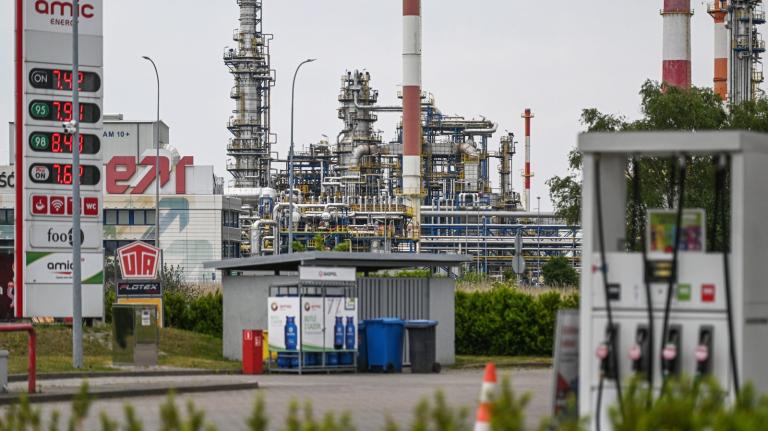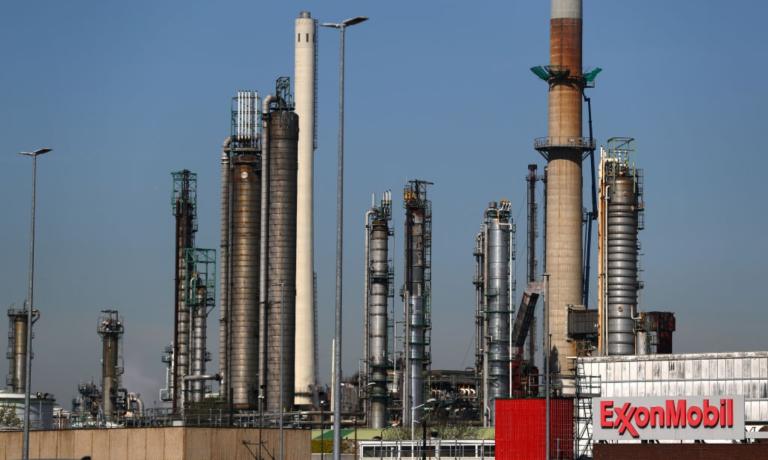Spiking gas prices, spurred by Russia’s invasion of Ukraine, and oil industry profits of $200 billion prompted widespread calls last year for price-gouging investigations. President Biden even threatened to impose a windfall tax on Big Oil if it didn’t invest some of those record profits into lowering costs. But the sector’s financial secrecy, and its efforts to blame environmental regulations for the high cost of filling up, have made price gouging notoriously difficult to prove. Any legislative momentum to tax profits fizzled as attention shifted toward passing the Inflation Reduction Act.
California, where gasoline hit an average of $6.44 a gallon last summer, is changing that.
Last week, Governor Gavin Newsom signed legislation bringing unprecedented transparency to how oil companies like Chevron, Phillips 66, and Valero operate in the state. It also creates a market oversight division within the California Energy Commission that could, depending upon its findings, limit gasoline refining margins — the amount refineries earn per barrel of gasoline after subtracting production costs. Any ceiling the commission establishes would come with a penalty for those that exceed it.
Newsom said it could take up to a year to assemble the watchdog branch. While there is no guarantee it will cap oil industry profits, climate groups, consumer advocates, and environmental justice organizations are hopeful that the law will bring relief.
“The [commission] was mostly a reporting agency,” said Jamie Court, president of the nonprofit Consumer Watchdog, “and now we’re creating a watchdog bureau.” Whether it aggressively pursues profiteering remains to be seen, he said, “but my bet is on the governor getting this right.”
The law is the first in the nation that attempts to bar Big Oil from inflating gasoline prices, blaming those increases on government regulations, and using its profits to block environmental and climate policies, said Kassie Siegel, senior legal counsel with the Center for Biological Diversity. Siegel, who has spent more than a decade working on oil and gas issues in the state, notes that the industry recently spent $20 million to place a referendum on next year’s ballot that would roll back health protections for neighborhoods impacted by drilling.
“Their number one talking point is that the protections will increase gas prices,” she said, “but the hearings for this bill showed that that’s not true — the real culprit is price gouging.”
Catherine Reheis-Boyd, president and CEO of the Western States Petroleum Association, disputed that and called the legislation “troubling” because it does not address what the industry considers the underlying reason prices rise.
“The biggest way to impact prices at the pump is to bring more supply,” she said. “And what’s happening right now is every policy we’re passing, whether it’s a windfall profits tax, whether it’s a governor who won’t issue permits on crude oil, whether it’s restricting any kind of ability to get more oil to market — all those things tighten supply and increase price.”
Californians pay the highest fuel prices in the nation. Last summer, they handed over as much as $2.60 more per gallon than the national average. Newsom has since last fall targeted oil companies that operate in the state, blaming them for high gas prices and calling for a windfall tax. In December, he convened a special legislative session and proposed that the legislature limit refinery profits and establish fines for those that exceed the cap. But even Democratic allies worried that they lacked enough information to do that; some also feared the legislation would encourage refineries to produce less gasoline or sell what they make out of state, increasing prices for Californians.
Earlier this month, the governor offered a revised bill that gave the energy commission authority to investigate, define, and set limits on price gouging. That bill moved quickly, and handily passed through both the Assembly and Senate.
Starting in June, oil companies must provide the commission with detailed information about their inventory, monthly profit margins per barrel of gasoline sold, and spot market transactions that, among other things, set the price retailers pay for gasoline. The companies also must report planned maintenance shutdowns. The watchdog division will have authority to subpoena oil companies for information. Any profit threshold and penalty it eventually sets would be determined through a public rule-making process and must account for any adverse impacts to consumers.
During hearings on the proposal, Republicans echoed oil industry claims that California’s environmental laws, including its drilling regulations, are to blame for high gas prices because they restrict supply and require refineries to pay more for crude oil.
But consumer advocates say their analyses of refinery profit margins already account for the price of oil and the cost of complying with California regulations. The fact that the state’s five refineries export at least 3 percent of their product from a market with the nation’s highest prices (even after accounting for taxes) indicates that there’s not a shortage, said Robert McCullough, an economist who has studied energy markets for decades. Other estimates put California’s gasoline exports at above 20 percent.
As of last summer, California’s gas tax of 54 cents per gallon was one of the highest in the country, but ongoing analyses by University of California, Berkeley economist Severin Borenstein show that taxes, environmental fees, and the cost of making the cleaner gasoline the state requires can’t explain the high prices residents pay. His research shows that a “mystery surcharge” appeared in 2015.
Borenstein told Grist that his analyses found the surcharge mostly occurs downstream of the refineries; in legislative hearings he pushed for additional transparency measures in the bill that include contracts and sales between refineries and retailers. Court and Siegel believe surcharges happen at different points in the supply chain, but said they have no question that profiteering occurs at the refinery level.
Based on investor reports and other information, “we know how much they charge, what their costs are, and the gross refining margin that they’re reporting to the state monthly,” Court said. “When the gas prices [were at their highest], that’s when their margins were at their highest.”
McCullough said the data from the Oil Price Information Service, used by traders, shows higher fuel prices even when crude oil costs are declining and production is increasing, but complete information is not readily available to the press or policymakers because of confidentiality orders. “[This new law] will make quite a difference for the California Attorney General’s office, which would otherwise have to go through a lengthy legal proceeding to get access to similar data.”
The California Attorney General’s office cosponsored the bill, which will allow the energy commission to refer matters for prosecution. The office has investigated the oil industry many times over the past decade, and current Attorney General Rob Bonta is suing two multinational oil trading firms his office says took advantage of a 2015 explosion at a refinery in Torrance, California, to drive up gas prices. By requiring Big Oil to report more basic information upfront, the office will be able to see in nearly real time what is happening in the market, identify problems, and move to fix them faster, a spokesperson said.
Price gouging traditionally is defined as occurring when a company charges more for a product during a state of emergency than it typically does. In this case, California would define price gouging as charging too much, regardless of whether an emergency exists. The commission, through hearings, will determine what constitutes “too much.”
Court has a suggestion.
“Oil refineries have historically made about 32 cents of profits per gallon,” he said. “Last year, their average for the year was 66 cents per gallon.” His organization thinks the line should be drawn at 50 cents per gallon, which has occurred just three times in the last 20 years, each time for Chevron. The commission also will consider regulating profit margins on the basis of monthly averages.
It remains to be seen whether California’s efforts to regulate oil industry profits will catch on, but Jamie Henn, director of Fossil Free Media, is optimistic. Henn, who was named to the 2022 Grist 50 list of emerging climate leaders, worked on federal legislation sponsored by U.S. Senator Sheldon Whitehouse of Rhode Island and Representative Ro Khanna of California to impose a windfall profit tax on Big Oil that the pair reintroduced this year. He said a poll conducted in May 2022 found that almost 80 percent of registered voters wanted greater accountability for energy-price manipulation. “Most people agree the White House hasn’t been the most effective at responding to those allegations,” Henn told Grist.
“California’s really important because they’re moving forward into action in a concrete way,” said Henn. “I think we’re going to see a wave of efforts like this to go after the industry’s profiteering, price gouging, and illicit business practices.”
The Golden State is the oil industry’s most profitable domestic market, and its residents are particularly vulnerable to price gouging because of its status as an “energy island.” Other states have pipelines that bring in oil from around the country and have backup supplies. But 98 percent of California’s gasoline is produced within the state by five refiners that import over two-thirds of their oil. Their control of the market gives them greater power in setting prices and leads to spikes when they go offline.
Critics of California’s plan worry that capping profits and levying fines could lead to a reduction in gasoline supplies or cuts in production. But consumer advocates say the legislation provides tools to avoid that, such as giving the energy commission more power to engage with the refineries and prevent them from all going offline for maintenance at once.
“The two best ways to keep gasoline prices low are transparency and disincentives,” said Mccullough. “Newsom’s law has both.” As an example, he cites the 2000–2001 California energy crisis, where energy traders drove up prices through market manipulations that contributed to severe power shortages.
“The crisis came to a close on June 10, 2001 — the day the [Federal Energy Regulatory Commission] imposed effective price caps,” said McCullough. “The next day the plants stopped breaking down, the prices fell, and the Enron scams ceased — simply because there was no longer any incentive to misbehave.”






